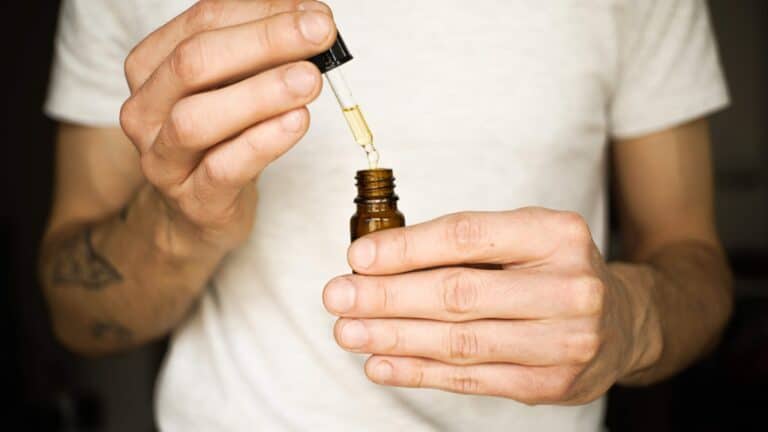How to Make CBD Oil & Can You Extract It at Home?

After seeing the price tags for popular CBD products, it’s understandable that you’re looking for instructions on how to make CBD oil yourself. You might wonder – is it even possible? The answer? It absolutely is!
Many of the top brands were started by people who simply wanted to make CBD at home and see what will happen. However, there are definitely some things to take into consideration (like if it’s even legal where you live). There are also various extraction methods, different strains of hemp that you can extract CBD from, and so on.
Don’t let this scare you though, it’s still a simple process. This article will share just how easy it is to make your own cannabidiol oil at home!
Where Does CBD Come From?
Before we get into it, let’s introduce the science of CBD to fully understand how the process works. CBD is one of the 100+ cannabinoids found in cannabis plants and it has a wealth of health benefits. It’s extracted from hemp plants that are particularly bred to have high CBD content.
CO2 & Ethanol: Two Common Extraction Methods
When purchasing products from one of the best CBD oil brands, you’ll mainly encounter two possible extraction methods that they use – CO2 or ethanol (alcohol). CO2 is the most popular for large brands, but a few use ethanol instead. These are both healthy and effective methods of extraction.
There are also a couple of other methods that very select few brands use, but we’re focusing on the following two main CBD extraction methods for now:
- CO2 extraction: Uses special equipment that pressurizes cannabis at particular temperatures to extract CBD and other molecules of the plant.
- Solvent extraction: This easier method simply uses ethanol, also known as alcohol, as a solvent. The hemp or marijuana plant is steeped in the alcohol, which brings out the full spectrum of cannabinoids from the plant. There is no alcohol leftover in the final product. You can also use various oils as solvents instead of alcohol.
Is It Legal to Make Your Own CBD Oil?
Nobody wants the cops knocking at their door while innocently crafting up some nonpsychoactive CBD oil. That’s probably not going to happen, but it’s good to be careful. The Farmers Bill passed in 2018 made CBD with less than 0.03% THC legal in all 50 states.
This means it needs to be extracted from the strains of cannabis with very low THC content. Although CBD oil without THC or very little is legal, trouble arises when you try to source these plants. It’s hard to acquire hemp for CBD purposes unless you grow them yourself, or you live in a state where marijuana is completely legal. This is because they’re only readily available at dispensaries – you can’t run to the supermarket and purchase CBD-rich hemp.
How to Make CBD Oil at Home
Now that we’ve gone over the legality and where it comes from, let’s get into the juicy part. You might imagine making your own CBD is a complex process, but it’s surprisingly easy. It’s so simple that you can extract CBD from the comfort of your own home with very little effort or supplies!
1. Advanced: CO2 CBD Extraction
As we mentioned earlier, CO2 extraction is more advanced because you need physical equipment and skills. This isn’t an ideal at-home extraction method if you’re just looking to make products for yourself. The expensive equipment can cost anywhere from tens/hundreds of thousands of dollars, to over $1 million for a high-end machine!
It uses highly pressurized carbon dioxide to extract CBD and other cannabinoids. Some call this cold pressed CBD oil, but its temperatures vary depending on whether you’re using the subcritical, supercritical, or mid-critical method. They are typically cold temperatures, however.
There are other options for this method though. You don’t have to purchase this machine yourself – you can outsource and partner with one of the top CBD extraction companies. They’ll extract the CBD for you using the CO2 method with their own equipment. Some even provide the hemp themselves, and some can help you build your CBD brand!
Even with outsourcing, this method is too difficult for most of us normal people who aren’t trying to start an entire company. Let’s get onto the easiest DIY CBD oil.
2. DIY: Solvent Extraction (Alcohol or Oil)
The second most popular extraction method uses alcohol or oil as solvents. There are other types, but alcohol and oil are the most common. Solvents are the go-to methods for extracting CBD at home because they’re the easiest.
If you want to avoid using alcohol, you can also extract CBD using a carrier oil! Coconut and olive oil are the most common that you’ll hear about when learning how to make CBD oil at home, but you can use nearly any oil.
It’s very simple to make, and you probably even have most of the supplies needed. You simply need a CBD-rich hemp plant, a cooking pot, alcohol or oil, and a little bit of time.
Make Your Own CBD Oil Step-by-Step Instructions
Let’s use olive oil as the first example.
Mix high-quality olive oil with equal amounts of water in a cooking pot. Add your prepared hemp buds and start at fairly low heat, slowly increasing the temperature until tiny bubbles begin to float to the surface. Once this happens, slightly turn the heat down to stick to a low boil.
Side note: These instructions can be used for any other type of oil as well, including extracting CBD with coconut oil.
The ideal temperature is 200˚F, and you’ll want to use a thermometer to ensure the temperature doesn’t reach 300˚F. If it does, many of the cannabinoids and terpenes will release into the air rather than the oil.
This should cook this for about 30 minutes – you’ll be able to tell it’s ready because the water will look boiled out and the cannabis will begin floating to the top. Once finished, you should let the mixture cool and then strain using a fine mesh sieve. It can then be stored in any storage container with a lid.
The end result will be a full-spectrum CBD oil.
If you’re wondering how to purify CBD oil into an isolate, this will be a little more difficult and spendy. There aren’t any natural ways to purify the THC and other cannabinoids out of CBD, so you’ll have to purchase professional equipment.
However, isolate powder is even cheaper to buy than regular CBD oil! If you really need an isolate, you’ll probably want to purchase from a retailer instead of going through the difficult process of making it yourself.
How to Make CBD Oil from an Isolate
If you’re not worried about extracting the CBD from actual hemp plants, there’s still an easy way to make your own products with flexibility.
Using isolate is the easiest way to make your own CBD products! There are three simple steps to this.
- Buy pure isolate powder from a CBD retailer
- Measure out your preferred dosage
- Mix it with anything you want!
It can be added to food, drinks, topicals such as creams or moisturizers, carrier oils, and anything else you’d like. There are plenty of CBD isolate recipes!
Technically, this isn’t making your own – you’re not directly extracting CBD out of the plant. That part is already done for you. This is easier, gives you the flexibility to make your own products, and saves money since isolate is cheaper than other CBD products.
This method isn’t ideal if you want complete control over the processing and how your CBD is extracted. With the lack of regulations, it can be hard to trust even the top companies. There are third-party lab tests, but it’s still hard to say how processed their methods are. These are likely not the purest CBD oil selections.
It’s also not ideal if you want full-spectrum CBD oil. CBD isolate processes all of the additional cannabinoids and terpenes out of the plant extract, leaving only pure CBD. This makes the powder tasteless, so it’s easy to add to edible creations.
The downside? Although pure CBD is effective for many symptoms, you miss out on additional benefits. The 100+ extra molecules and terpenes in full-spectrum are even more beneficial for your health. These have also been shown to work in an entourage effect when combined CBD (meaning they work even more effectively together).
The best carrier oil for CBD isolate could be coconut oil, olive oil, or similar oil. These are fairly neutral and can be added to nearly anything!
Other Ways to Make CBD Products
Using CBD Tinctures
If you don’t want to go through the trouble of extracting it yourself, another way to make your own CBD products is by simply using a tincture or CBD oil you have.
How to make CBD oil using a tincture? It’s easy – simply take a store-bought tincture of your choice and drop your preferred dosage into any product! You can add it to food, drinks, skin creams or other skin products, and anything else you’d like.
What Plants Should You Use?
You may already know that hemp is used for making CBD, but this is such a broad statement. There are hundreds of different strains and types of the plant. That being said, the plant itself is a very important factor when determining how to make CBD oil at home.
Most CBD oils are extracted from hemp plants that are particularly bred with low THC content, which is the molecule that gets you high. You can extract it from marijuana as well, but there will be a higher THC content. Rather than CBD oil, this is typically called cannabis oil.
Some people enjoy this combination because CBD has shown to reduce the negative effects of THC (like disorientation and anxiety). It’s even been found that CBD and THC work better together for some symptoms.
The strain of plant used for extraction is very important as well. The top CBD strains are ACDC or Charlotte’s Web. These are bred to be high in CBD and low in THC, making them ideal for our purposes. If you want CBD with higher THC content, you’ll need to use a marijuana strain.
FAQs
How much CBD oil can I get from one plant?
This is a great question, and also a hard one to answer. It’s hard to measure how much CBD oil from one plant you can get because, for one, the prices of plants will vary. Growing it yourself is much cheaper! However, this requires effort, skills that can be learned through experience, and time (although it only takes about 60 days to fully grow). It’s more expensive to purchase the plant from a cannabis store, but you still save money versus buying CBD oil itself.
A farmer reports that each plant produces a half-pound of flower material that’s 18% to 20% CBD.
Which part of the plant is CBD made from?
All of it! CBD is extracted from the entire bud.
What is the best oil to use for extraction?
Both olive oil and coconut oil make great carrier oils for extraction. They’re pretty similar oils, so it really depends on personal preference. You might prefer coconut oil if you like the taste of coconut or are using it for your skin. For example, a CBD coconut oil topical would be super moisturizing if you have dry skin.
Is there cold pressed CBD extraction?
Many products that are CO2 extracted use cold temperatures, which means they are cold pressed. However, it’s hard to know for sure unless that company directly states which method and temperatures they use.
How can I make my own CBD salve?
The steps for how to make a salve with CBD oil are very simple. You can use a store-bought isolate, regular CBD oil, or a CBD oil that you extracted yourself. You’ll simply measure out the dosage and mix it into the salve! This works whether you have a store-bought salve you’d like to add CBD to, or if you made your own salve.
What’s the CBD oil cost when extracting yourself versus purchasing from a retailer?
It’s hard to give exact prices, but it’s definitely cheaper to extract it yourself. Even so, there are some great options for inexpensive CBD oil from a retailer. For example, Lazarus Naturals has fantastic deals for high-quality products! If the instructions for how to make CBD oil are too difficult for your liking, this brand is a great inexpensive choice.





